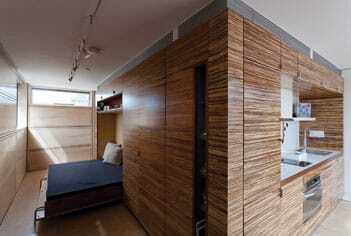| Students from the City College of New York built a structure designed to rest atop a pre-World War II mid-rise building in New York City. |
Notions of urbanism and density are creeping into the Solar Decathlon, a biennial solar home competition sponsored by the U.S. Department of Energy (DOE). While many of the prototypes on display in late September in Washington, D.C., still had a suburban or rural live-off-the-grid purpose, some university groups have begun to design homes attuned to the needs of the schools’ urban settings. And most entries employed a holistic approach to sustainable living, including water management and local sourcing of construction materials, even though such features are not rewarded under the competition’s criteria.
Uwe Brandes, an architect and urban planner who is ULI senior vice president of initiatives, toured the temporary solar village, evaluating how various designs could be adapted to dense, urban settings. “Overall, it’s interesting to see that a number of the student-designed houses are consciously transcending DOE’s constraints for the competition,” he said. “To me, this indicates that these students are interested in pursuing a deeper strategy of sustainability over the relatively simplistic idea of just putting solar panels on a prefabricated box. Water recycling, locally sourced materials, designs that engage exterior spaces—these are all strategies for connecting to local economies and environments.”
Certainly there remains a strong go-it-alone streak in many of the designs. A team from the University of Calgary, for example, designed a solar-powered home specifically for the needs of indigenous peoples living on the southern Alberta prairie, and students at Victoria University of Wellington, New Zealand, designed a vacation home for rural settings near that country’s coast. Students from Purdue University built a solar home, complete with a one-car garage, that could be slipped into a typical Indiana suburb incognito.
But students from the City College of New York built a structure designed to rest atop a pre–World War II mid-rise building in New York City. Not only could it provide solar power for its intended occupants and possibly energy for the host building, but also it incorporates a roof garden and stormwater-retention features.
| The University of Maryland team, whose house took top honors overall and won the architecture category, focused heavily on water management, a key ecological issue in the Chesapeake Bay watershed. |
“This tells an urban story,” Brandes said. “Certainly in New York there’s a huge trend in recovering rooftop space.” And Brandes noted that the compact design could be adapted to a ground-level urban setting. “You could imagine this stacked three or four high. Add an exterior stair, and then it becomes a walkup typology,” he said.
Over the course of two weeks, students open the homes to the public and compete in ten competitions: architecture; market appeal; engineering; affordability; communications; heat and humidity control; hot water production; appliance operation; home entertainment (hosting dinner parties and using televisions and other home electronics); and producing enough solar power to achieve net-zero energy consumption.
The University of Maryland team, whose house took top honors overall and won the architecture category, focused heavily on water management, a key ecological issue in the Chesapeake Bay watershed. Its home captured rainwater and recycled graywater from washing to irrigate its heavily planted outdoor gardens. The team also used a technology developed by the university for its 2007 decathlon entry. The technology incorporates a lithium chloride desiccant to reduce indoor humidity, easing demand on the air conditioning system. A patent on the technology is pending.






